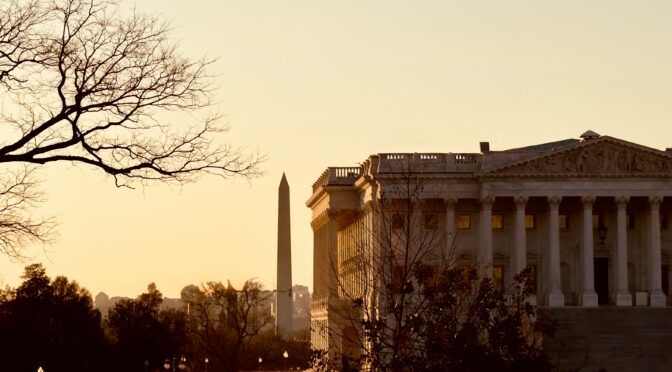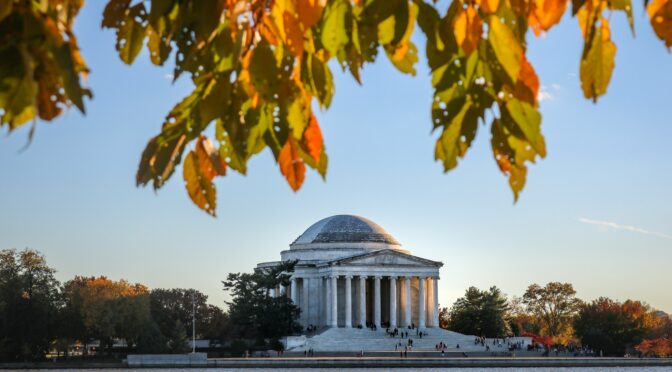By Sean Robins, NACAC’s director of advocacy
Welcome to this issue of the Advocacy Update on NACAC’s Admitted blog. After a 43-day federal government shutdown — the longest in U.S. history — agencies are reopening, backlogs are emerging, and the full scope of the disruption is becoming clearer by the day. As institutions, students, and college admission counselors continue to navigate the uneven path toward recovery, federal policy activity is accelerating across all branches of government. This week brought significant administrative actions reshaping the U.S. Department of Education, new court decisions with national implications, major enrollment and research trends, and continued debates on Capitol Hill.
Congress is also preparing for the year ahead, with both the House of Representatives and the Senate releasing their 2026 Congressional Calendars — a reminder that many of the issues unfolding now will define the policy landscape well into next year.
As we head into the Thanksgiving holiday next week, we want to extend our gratitude for the work you do every day to support students and center equity in the college admission process. Because of the holiday, the next Advocacy Update will be published on Dec. 5. With so much in motion, NACAC remains focused on providing clarity, elevating member voices, and ensuring that federal decisions strengthen, not undermine, the pathways students rely on to access and complete postsecondary education.
Policy & Legislative Updates
Federal agencies are still digging out from the 43-day shutdown. As staff returned, many found locked systems, frozen grants, backlogs stretching months, and projects that simply halted. While backpay provided some relief, agency officials warned that the operational damage — from stalled civil rights investigations to delayed Impact Aid, shuttered Head Start programs, and cybersecurity lapses—will ripple well into next year. The instability highlights just how fragile education and early childhood systems have become as Congress again postpones long-term funding decisions.
These fiscal pressures are compounding across higher education. A new Pew analysis shows public colleges bracing for a worsening financial landscape as state budgets tighten, federal reductions loom, and enrollment declines continue. Even “flat” budgets amount to cuts once inflation and operating costs are considered. Research institutions warn that new caps on indirect cost reimbursements, paired with federal cuts, could destabilize regional economies and research pipelines. With international enrollment down and tuition revenue strained, institutions face another year of uncertainty with few pathways to relief.
Despite these pressures, new Common App data show a modest bright spot: early application volumes are up, particularly among Black, first-generation, low-income, and rural students. Yet international applications are falling sharply, driven by visa delays and denials under the Trump administration. The most selective campuses are seeing the slowest growth, and test score submissions have increased as more institutions reinstate requirements — though first-generation and underrepresented students remain far less likely to report scores.
Those trends mirror the latest Institute of International Education (IIE) report, which shows a 17 percent drop in new international student enrollment this fall, especially among graduate students. Campuses cite visa barriers, travel restrictions, and the administration’s immigration crackdown as central drivers. The financial stakes are real: last year, international students contributed nearly $55 billion to the U.S. economy, and this fall’s decline alone represents more than $1.1 billion in lost revenue. Institutions that saw growth attributed it to extensive outreach and advising — underscoring how federal policy is shaping global talent flows.
A major federal court ruling this week also carries national implications. A judge blocked the administration’s attempt to punish the University of California system by suspending future grants and demanding billions related to civil rights investigations. The decision prohibits agencies, including NIH, NSF, and the Education Department, from using funding freezes as leverage and reaffirms that the administration cannot sidestep Title VI due process or coerce institutions in violation of constitutional protections. At stake is the stability of the research enterprise and the principle that civil rights enforcement cannot be weaponized against campuses.
As colleges confront enrollment pressures, institutions are increasingly easing admission processes — expanding direct admission, offering one-click applications, waiving fees, and extending deadlines. While these shifts help reduce procedural barriers, they also reveal the depth of the enrollment decline and the limits of access reforms that don’t address affordability, advising, or the broader structural barriers that shape whether students enroll and finish a degree.
States are now facing a parallel legal front. Texas Attorney General Ken Paxton filed a lawsuit seeking to dismantle three need-based work-study programs, arguing that longstanding restrictions on sectarian work and participation by seminary students amount to unconstitutional discrimination. These programs provide essential wages and training to low-income students. Paxton’s challenge echoes recent cases that threaten evidence-based state policies and could limit access to critical supports.
National research competitiveness also surfaced as a major concern. New data shared at the APLU conference indicate that China may have already surpassed the U.S. in total research and development spending — even before the shutdown froze federal grants for weeks. With proposed cuts looming and federal investments largely flat for two decades, agencies like NIH and NSF are only now restarting award cycles. Short-term funding bills add more instability, raising alarms about talent loss and long–term impacts on U.S. competitiveness.
The administration has now taken its most sweeping step toward dismantling the U.S. Department of Education. On Nov. 18, the Education Department announced six new interagency agreements that transfer major program offices and funding streams to the Departments of Labor, Health and Human Services, State, and Interior. Combined with an initial agreement executed in July, these shifts move oversight of more than 80 federal education programs — totaling nearly $34 billion annually — out of the department and into agencies with very different missions and capacities.
These agreements touch every part of the department’s core work. The Department of Labor will now assume responsibility for almost all K-12 formula and competitive grants, Title I among them, along with most Higher Education Act programs, adult education, and career and technical education. HHS will oversee CCAMPIS and foreign medical education accreditation, State will take on international and foreign language programs, and Interior will administer 14 Indian education programs.
While framed as efforts to “better align” programs with workforce or national security priorities, the transfers align directly with the administration’s goal of eliminating the Education Department. The scale of the shifts raises major concerns about agency capacity, legal authority, and continuity for students, counselors, and institutions — all at a time when clarity and stability in federal education policy are urgently needed.
Courts remain a critical check in the current landscape. A federal court ruling halted Texas’s mid-decade congressional map, finding substantial racial gerrymandering. The state has already appealed to the Supreme Court, adding another high-stakes voting rights case just weeks before candidate filing deadlines.
During this week’s House Education & Workforce Committee hearing on lowering college costs, members highlighted dual enrollment, course sharing, and AI as promising tools — but the discussion quickly turned to the broader federal policy environment. Witnesses underscored that innovation cannot compensate for the administration’s proposed elimination of subsidized loans, deep cuts to research, or efforts to dismantle the Education Department. Investments in programs like TRIO, GEAR UP, and IES remain essential to any affordability strategy.
At the state level, Alaska’s Education Department is transferring ownership of deteriorating rural schools to local districts as a condition of long-overdue repair funding. Many of these communities — predominantly Alaska Native and without local tax bases — warn that taking title to buildings with structural failures, contamination, and major safety risks exposes them to liability they cannot manage. Leaders say they have little choice, highlighting the inequities rural districts face nationwide.
Lawmakers on Capitol Hill are also pushing back on reports that the administration is considering selling portions of the federal student loan portfolio to private companies. More than 40 Democrats warned that such a move could violate federal law, erode borrower protections, and result in significant taxpayer losses. They stressed that safeguards like income-driven repayment, PSLF, and discharge authorities must remain intact regardless of loan ownership.
In another important legal development, a federal judge allowed Kentucky Students for Affordable Tuition to intervene and defend the state’s in-state tuition policy for undocumented students. The state’s higher education board had agreed to end the benefit under administration pressure, leaving students at risk of losing access to courses, credentials, and progress toward their degrees. The court’s ruling affirms the need to protect inclusive tuition policies that expand opportunity and economic mobility.
The administration’s anti-DEI campaign is also intensifying. A new State Department proposal would remove 38 universities from the Diplomacy Lab program because they use diversity, equity, and inclusion-related hiring practices. Institutions labeled as having “clear DEI hiring policies” would be replaced with schools deemed “merit-based,” upending longstanding federal research partnerships and extending the political targeting of campus DEI initiatives.
Finally, state leaders are raising alarms about the weakening of statewide longitudinal data systems — the tools that help policymakers understand student pathways from early childhood to the workforce. While 32 states operate these systems, many lack the resources and modernization needed to keep pace with rapidly changing labor markets, especially as apprenticeships and AI-driven career shifts expand. With declining state appropriations, inconsistent federal support, and the administration proposing to eliminate dedicated funding for longitudinal systems, states risk making policy “in the dark” at the very moment students and institutions need clear, evidence-based guidance.
NACAC Advocacy
This week, NACAC continued advocating for policies that support students and protect institutional stability. NACAC joined higher education organizations in urging National Defense Authorization Act (NDAA) conferees to adopt balanced, evidence-based research security measures that strengthen national interests without disrupting campus operations or global collaboration. The letter supports bipartisan language aligned with existing federal frameworks and preserving essential indirect cost structures, while warning against overly broad proposals — including the SAFE Research Act and other House and Senate provisions — that would duplicate current processes, impose unworkable restrictions, or risk chilling international research partnerships. It also flags provisions that could jeopardize funding for institutions responding to antisemitism under their civil rights obligations.
NACAC also issued a public statement responding to the administration’s newly announced interagency agreements transferring major education programs out of the Department of Education. These moves represent a significant escalation in the administration’s effort to dismantle the department and fragment its core functions across agencies with no dedicated education mission. NACAC underscored that such actions weaken federal oversight, sidestep Congress, and introduce deep uncertainty for students, institutions, and the counselors who support them. We remain fully committed to defending a strong, coordinated federal role in education and will continue advocating for the stability and protections our members and students deserve.
Ways You Can Take Action
We are continuously updating our Take Action page with opportunities to make your voice heard. If you have not already, I encourage you to advocate on the urgent issues below. You can also view all active advocacy campaigns in the yellow column of the Take Action page.
- Tell Congress: Protect FSEOG and Work-Study Funding
- Tell Congress: Save TRIO and Support College Access
- Tell Congress: Prioritize Visa Appointments for International Students and Scholars
- Urge Congress to Protect Postsecondary Pathways
- Tell Congress: International Students are Essential to America’s Safety, Economy, and Global Strength
- Tell Congress to Not Abandon Our National Commitment to Education
- Urge Congress to Protect Disabled Students
- Don’t Flunk the Future Advocacy Toolkit
The policy landscape continues to shift quickly, with the Trump administration’s efforts to dismantle the only federal agency dedicated to children and students unfolding alongside new enrollment trends, court decisions, and ongoing debates in Congress. Through all of it, NACAC remains focused on ensuring that federal decisions strengthen, rather than destabilize, the pathways students rely on to access and complete college. Your work on the ground, supporting students and advocating for equity every day, continues to anchor our efforts in Washington, D.C.
As we look ahead, I am reminded of William Faulkner’s reflection on the power of collective action: “Never be afraid to raise your voice for honesty and truth and compassion against injustice and lying and greed. If people all over the world… would do this, it would change the earth.”
In a moment defined by uncertainty and change, raising our voices — together — remains our most powerful tool. NACAC will continue to stand with you, speak up for the students and communities we serve, and press for policies that protect opportunity and uphold fairness and opportunity in higher education.



